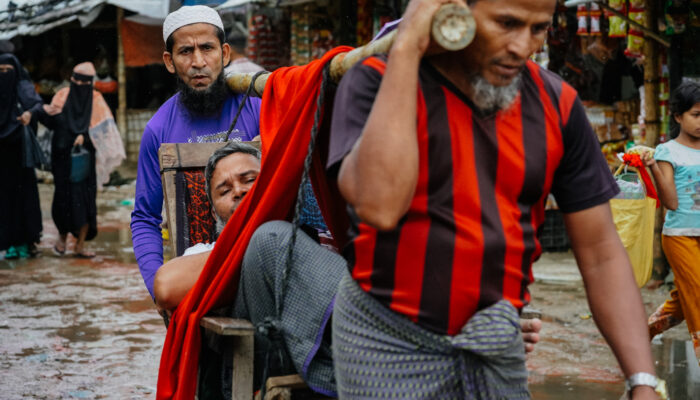
A man is transported to a health facility in the Kutapalong refugee camps near Cox’s Bazaar, Bangladesh.
Please read the summary report here.
This month, it has been eight years since the Burmese military launched a full-scale military attack on the Rohingya people. Over 700,000 Rohingya people fled to Bangladesh from Myanmar. In Rakhine state, the Arakan Army has faced increasing accusations that it is abusing, targeting, and disenfranchising the Rohingya. Humanitarian access is largely blocked. While the World Food Program reports alarming levels of food insecurity in Central Rakhine, they say the situation in Northern Rakhine, where the majority of Rohingya live, is expected to be even worse due to conflict and access issues. In Bangladesh, conditions in refugee camps such as Cox’s Bazar have worsened due to severe funding cuts, including reductions from USAID.
Currently, several important international meetings are held: at the end of August, a three-day conference in Bangladesh was organised by the Bangladeshi Ministry of Foreign Affairs and brought together global stakeholders to find solutions to the long-running Rohingya crisis. At this conference, the Bangladeshi government urged the international community to draft a roadmap for the safe and voluntary return of the Rohingya people. There will be a high-level conference in New York on 30 September, and another UN meeting is scheduled for December in Doha.
Against this backdrop, there is a critical window of opportunity to organise a roundtable discussion, bringing together humanitarian practitioners, policymakers, and academics. The objective of this meeting is to share knowledge and information about the most pressing challenges in humanitarian assistance for the Rohingya people.
This meeting focuses specifically on the plight of the Rohingya people, whilst KUNO and participants acknowledge that increased attention is also needed for other ethnic groups in Myanmar living in dire humanitarian conditions.
After the introduction, the floor is opened for the discussion.
– Picture Zia Sahat Hero and Victor Caringal (MSF), in June 2025, they produced a series of photographs to show how the Rohingya have adapted to daily life in the Kutapalong refugee camps near Cox’s Bazaar, Bangladesh –